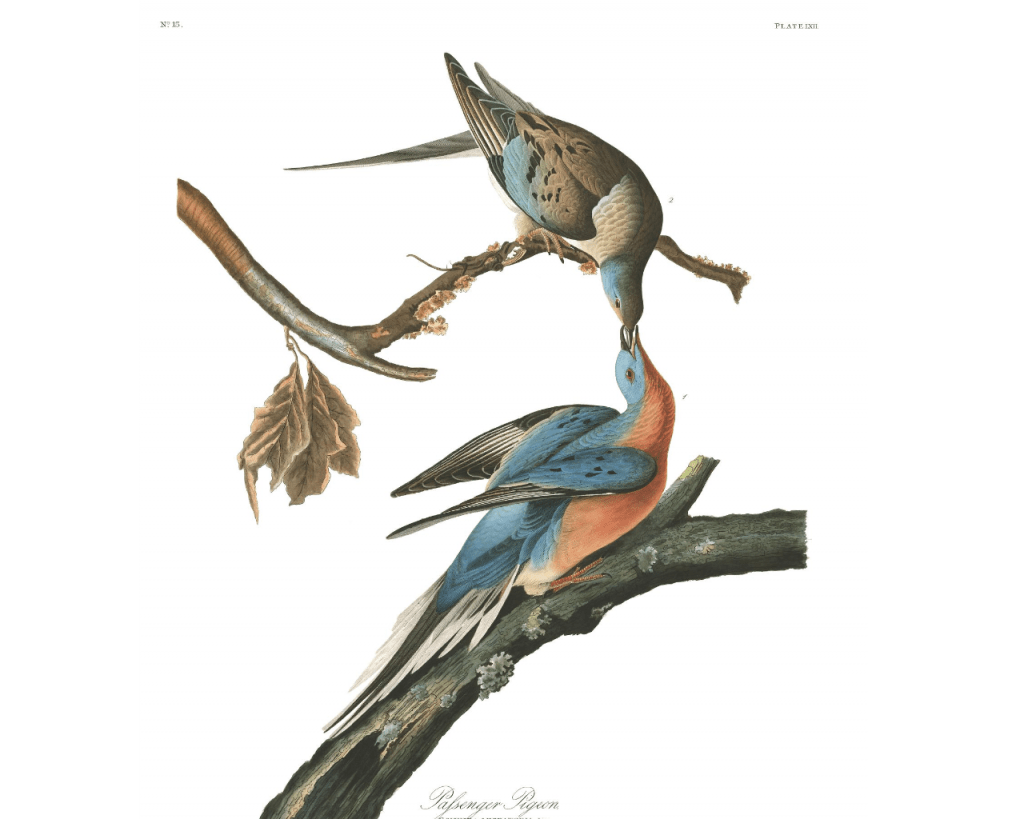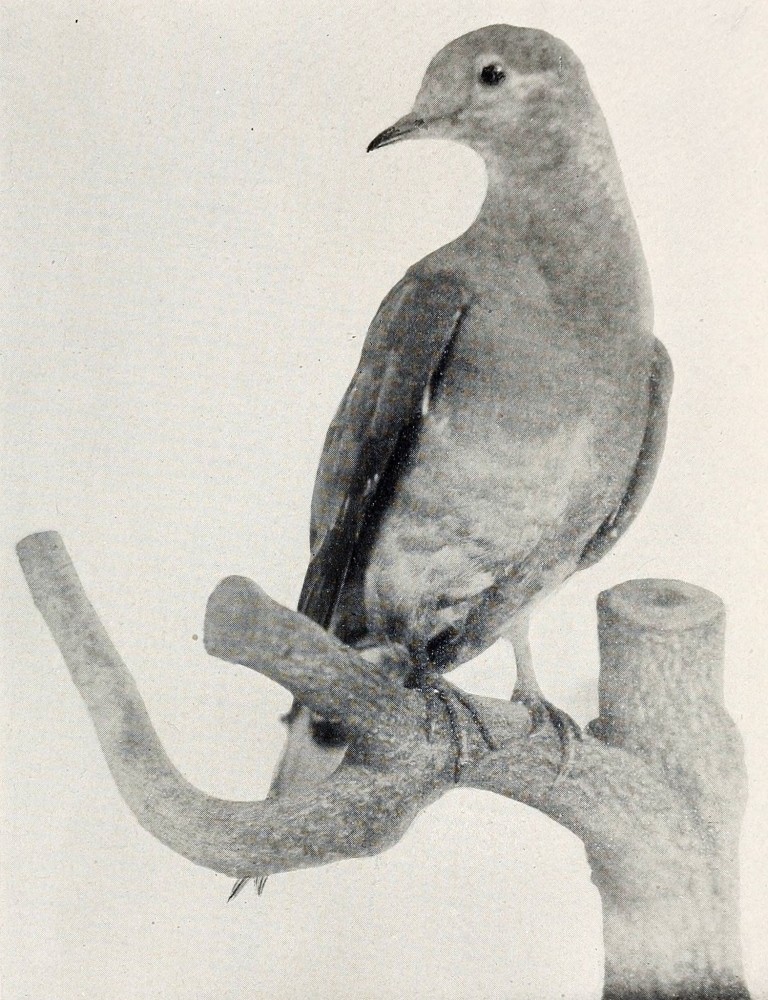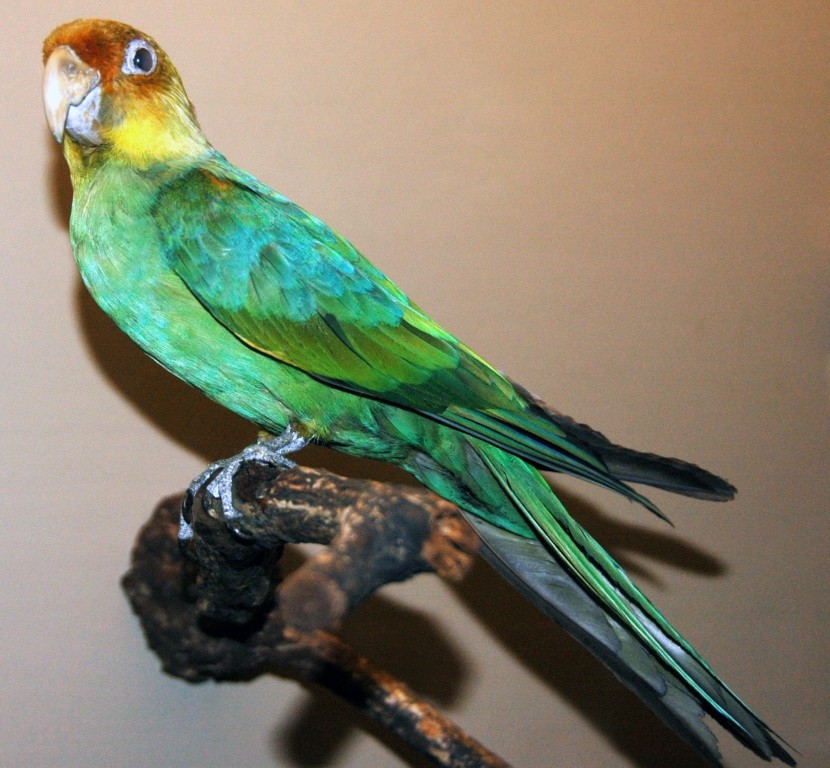I always look forward to posting the entries that our Natural Science Curator, Dr Gerard McGowan writes for our blog, as he highlight interesting aspects of our collections that I might not have been aware of before, and this is no exception.
He writes:
Amongst the very fine collections in the Zoology Collections are some true iconic specimens. I have written about a couple of these before. Another pair of very rare but important specimens are currently on display at Cliffe Castle Museum, Keighley. They are two specimens of the extinct Passenger Pigeon, Ectopistes migratorius. This blog tells a little of their unfortunate story.
The Passenger Pigeon, Ectopistes migratorius, was once the most numerous bird species in North America. Between 1840 -1860 their estimated numbers were between 3 & 5 milliard (thousand million). These birds would migrate in flocks so large they reportedly ‘turned the sky black’. One flock was described in 1866 in southern Ohio as being 1 mile (1.5 km) wide and 300 miles (500 km) long and took 14 hours to pass. It is estimated this flock contained around 3.5 milliard birds.

The passenger pigeon was sexually dimorphic in size and coloration. The male was 390 to 410 mm (15.4 to 16.1 in) in length, mainly grey on the upper parts, lighter on the under parts, with iridescent bronze feathers on the neck, and black spots on the wings. The female was 380 to 400 mm (15.0 to 15.7 in), and was duller and browner than the male overall. The juvenile was similar to the female, but without iridescence.

CC 426-06 Passenger Pigeon, Catesby, was donated to Keighley Museum in 1905 by Seth Lister Mosley the first Curator of the museum (1902-1910).

CC 427-05 Passenger Pigeon, Swainson , was donated to Keighley Museum in 1910 by John Miller of Otley.
Although deforestation and the disturbance of their breeding grounds led to a reduction in numbers it was the mechanization of commercialized hunting that ultimately led to their extinction.
Despite putative attempts to legislate some protection of the passenger pigeon between the late 1850s until 1890s politicians ignored the requests of conservationists until it was too late. The passenger pigeon had almost disappeared by the mid-1890s so an 1897 bill introduced in Michigan for a 10-year closed season on hunting the bird came too late.

The last verified sighting of a wild passenger pigeon was at Laurel, Indiana on 13 April 1902. Only 30 years earlier this bird species had been the most numerous on the North American continent.
It was due to overexploitation, hunting for food and ‘sport’, and destruction of their nesting sites that led to the extinction of this once most populous of birds. The Passenger Pigeon was essentially extinct in the wild by the end of the 19th century.
By the end of 1907 only three captive passenger pigeons, in Cincinnati Zoo were known, one female named Martha and two males, after the other four males held in Milwaukee died that winter.
The first of the last two Cincinnati males died in April 1909 with the other male dying on July 10 1910. Martha, herself, the last know passenger pigeon, died in Cincinnati Zoo, Ohio on 1 September 1914.

Four years after Martha the last of the Carolina Parakeet, Conuropis carolinensis, died, ironically in Martha’s old cage. This was the only native parakeet in North America. It too succumbed to a combination of habitat loss, hunting and disease brought about by human hubris.

Extinct Britain: What’s Gone Extinct Locally?
The number of animals going extinct in Britain rises each year and has been increasing more recently because of changes in agriculture, climate change, loss of habitat and over hunting. Only a few of these species are globally extinct such as the Irish Elk, Great Auk, Woolly Mammoth and Woolly Rhinoceros, for example. Most of the remaining species survive elsewhere. Most local extinctions, which are termed extirpations, are the result of changes in the local ecology of an area
Mammals
Since the end of the last glaciation Britain has lost many mammals, most due to the warming climate. These include Cave lion (Panthera leo spelaea), Woolly Rhinoceros (Coelodonta antiquitatis), Woolly mammoth (Mammuthus primigenius), saiga antelope (Saiga tatarica) all around 10,000 BCE.
At around 8000 BCE the arctic lemming (Dicrostonyx torquatus), narrow-headed vole (Microtus gregalis), steppe lemming (Lagurus lagurus) and pika (Ochotona sp) all disappeared from Britain.
By 6000 BCE the tarpan, the European Wild Horse (Equus ferus ferus), wolverine (Gulo gulo) and the Irish Elk or Giant Deer (Megaloceros giganteus) had gone too.
The wisent or European bison (Bison bonasus) died out around 3000 BCE and both the Elk (Alces alces) and root vole (Microtus oeconomus) were extinct in Britain by 1500 BCE. Walrus (Odobenus rosmarus) disappeared from Britain’s shores around 1000 BCE (albeit with occasional visitors) and at the same time the wild Aurochs (Bos primigenius) went extinct too.
By 500 BCE the grey whale (Eschrichtius robustus) had also left Britain’s shores. The last native Eurasian lynx (Lynx lynx) disappeared around 400 CE with the last brown bear (Ursus arctos) disappearing between 500 & 1000 CE. The last major mammal to go extinct in Britain was the grey wolf (Canis lupis), with the last recording in 1680 with Ireland retain grey wolves until 1786.
Birds
The Great White Pelican (Pelecanus onocrotalus) circa 1000 BCE, the Cappercaillie (Tetrao urogallus) mid 17th century and the Great Auk (Pinguinus impennis) 1844 have been driven to extinction in Britain.
From the end of the last glaciation with a warming climate and increased pressure on the land from humans the numbers of many birds and their distributions have been significantly reduced and in many cases wiped out.
By the end of the Iron Age, circa 100 CE, the Dalmatian Pelican (Pelecanus crispus) was extinct due to hunting, and Cory’s Shearwater (Calonectris dioedea), the Eurasian Eagle Owl (Bubo bubo) and the Barnacle goose (Branta leucopsis) no longer bred in Britain.
By the early 1600s the Common Crane (Grus grus) and the Eurasian Spoonbill (Platalea leicordia) were lost due to the draining of wetlands for farming. This practice also led to the demise of other species such as the Goshawk (Accipiter gentilis) in the 19th century, the Great Bustard (Otis tarda) in the 1840s, the Black-tailed godwit (Limosa limosa) in 1885, the Ruff (Philomachus pugax) in 1871, the Black Tern (Childonias niger) in 1885 and Osprey (Pandion haliaetus) in 1916.
Other birds came very close to extirpation such as the White-tailed eagle (Haliaeetus albicilla), red kite (Milvus milvus) and the Corncrake (Crex crex).
Amphibians & Reptiles
The Agile frog (Rana dalmatina) and Moor frog (Rana arvalis) both were extirpated around 1000 CE with the European pond terrapin (Emys orbicularis) last recorded in the fossil record at around 3000 BCE.
Fish
The houting (Coregonus oxyrinchus) a fish related to salmon was once common in the rivers of northern Europe and England. Most probably became extinct in England in late 19th century due to pollution and overfishing.
Invertebrates
Over the last 150 years the following insects have disappeared from Britain.
| Butterflies | |||
| Species name | Binomial | Approximate last date | |
| Large Copper | Lycaena dispar dispar | 1865 | |
| Black-veined White | Aporia crataegi | 1925 | |
| Large Blue | Maculinea arion | 1979 | |
| Mazarine Blue | Cyaniris semiargus | 1906 | |
| Moths | |||
| Isle of Wight Wave | Idaea humilata | 1931 | |
| The Many Lined | Costaconvexa polygrammata | 1875 | |
| Frosted Yellow | Isturgia limbaria | 1914 | |
| Speckled Beauty | Fagivorina arenaria | 1885 | |
| White Prominent | Leucodonta bicoloria | 1865 | |
| Reed Tussock | Laelia coenosa | 1875 | |
| Gypsy Moth | Lymantria dispar | 1907 | |
| Scarce Black Arches | Nola aerugula | 1898 | |
| Small Ranunculus | Hecatera dysodea | 1937 | |
| The Conformist | Lithophane furcifera suffusa | 1880 | |
| Flame Brocade | Trigonophora flammea | 1919 | |
| Orache Moth | Trachea atriplicis | 1915 | |
| Union Rustic | Apamea pabulatricula | 1919 | |
| Viper’s Bugloss | Hadena irregularis | 1977 | |
| An additional 56 species of Lepidoptera were lost from Britain before 1900 | |||
| Odonata (dragonflies and damselflies) | |||
| Species name | Binomial | Approximate last date | |
| Norfolk damselfly | Coenagrion armatum | 1957 | |
| Dainty damselfly | Coenagrion scitulum | 1953 | |
| Orange-spotted Emerald | Oxygastra curtisii | 1957 | |
| Coleoptera (beetles) | |||
| Species name | Binomial | Approximate last date | |
| A ground beetle | Agonum sahlbergi | 1914 | |
| A ground beetle | Harpalus honestus | 1905 | |
| A ground beetle | Scybalicus oblongiusculus | 1926 | |
| A water beetle | Rhantus aberratus | 1904 | |
| A water beetle | Graphoderus bilineatus | 1906 | |
| A water beetle | Ochthebius aeneus | 1913 | |
| An histerid | Teretrius fabricii | 1907 | |
| A tenebrionid | Platydema violaceum | 1957 | |
| Hymenoptera (bees, wasps and ants) | |||
| Species name | Binomial | Approximate last date | |
| A mason wasp | Odynerus reniformis | 1915 | |
| A mason wasp | Odynerus simillimus | 1905 | |
| A digger wasp | Mellinus crabroneus | c1950 | |
| A mining bee | Andrena polita | 1934 | |
| A mining bee | Halictus maculatus | 1930 | |
| A mining bee | Eucera tuberculata | 1941 | |
| Short-haired bumblebee | Bombus subterraneus | 1988 | |
| Cullem’s bumblebee | Bombus cullumanus | 1941 | |
| An additional 18 species of hymenoptera were lost from Britain before 1900. | |||
| Trichoptera (caddis flies) | |||
| Species name | Binomial | Approximate last date | |
| A caddis fly | Hydropsyche bulgaromanorum | 1926 | |
| A caddis fly | Hydropsyche exocellata | 1901 | |
Recent Conservation Success Stories
Over recent years some success has been seen at reintroducing some of these lost species.
The Capercaillie was successfully re-introduced to Scotland from Swedish stock in the mid-19th century although numbers have dramatically fallen in the last 25 years. There are fears that they may again be extirpated from Britain. The white-tailed eagle has been introduced successfully on the west coast of Scotland. The red-kite, osprey and corncrake have been successfully introduced to several sites in Scotland and England, including Yorkshire. The great bustard is currently being established on Salisbury plain.
Plans to introduce wild European beaver back into parts of Britain were begun in 2009 with the release of breeding pairs into Knapsdale, Argyll. Moose were released into fenced reserves on the Alladale Estate in the Highlands. Reindeer have been successfully living and breeding around the Cairngorms in Scotland since 1952.
The pool frog was reintroduced from Swedish stock in 2005 to a site in Norfolk.
The Large Blue butterfly (Maculinea arion) was also successfully reintroduced from Swedish stock at a number of sites in Britain. In contrast despite concerted efforts to protect the habitat of the heath fritillary (Melitaea athalia), regarded as the most threatened UK butterfly in 1980, numbers have continued to decline.
Currently, plans are being discussed to reintroduce Lynx back into mainland Britain. An application was made to Natural England in July 2017 to reintroduce 6 Lynx, for a trial 5-year period, into England’s largest forest, Kielder Forest in Northumbria, which has just reported its first Pine Martin after 90 years absence. It has been suggested by previous rewilding studies that the reintroduction of Lynx, as a top carnivore, will act as a natural predator of wild deer keeping their numbers in check. The culling of deer by humans does not provide the same benefits as natural predation because the latter changes the behaviour of the deer. With predators in the environment deer tend to remain in higher wooded areas to remain hidden. This allows regrowth of trees in open areas, which, without predators, is prevented by deer overgrazing the saplings. The regrowth of natural woods and forests provides additional habitats for other species leading to greater diversity which in turn leads to improved stability of the environment and ecosystems. A positive trial may result in additional reintroductions such as Elk, Grey Wolves, Wild Boar and Brown Bear, all once part of a more natural ecosystem across Britain.
In addition to the reintroduction to these top trophic level animals there are a number of initiatives that hope to save other smaller, but equally important, species and habitats such as the Back From The Brink project which hopes to save important insects, reptiles and plant ecosystems.